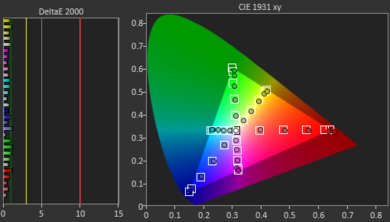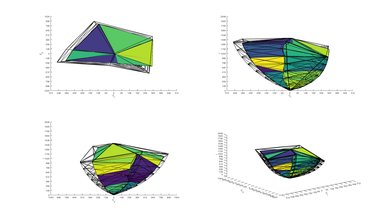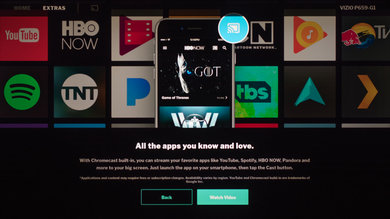Our Verdict
Overall, the Vizio P Series Quantum 2019 is a great TV for almost any usage. It's a great choice for movies or games in a dark room, and HDR content looks great in a dark room. It's also a very good choice for TV shows or sports in a bright room, but the image degrades at an angle, so it isn't a great choice for a wide seating area or for watching the big game with a group of friends.
- Great peak brightness.
- Deep blacks and a great local dimming feature.
- Outstanding wide color gamut.
- Noticeable uniformity issues.
Great TV for watching movies in a dark room. It has excellent contrast and a great local dimming feature, so blacks look black in a dark room. It also has good black uniformity, and it can remove judder from 24p sources or the native apps.
This is a very good TV for watching TV shows in a bright room. It has very good reflection handling and great peak brightness, so glare shouldn't be an issue in most rooms. Unfortunately, lower-resolution cable shows aren't upscaled as well as on other brands, and it has a limited selection of streaming apps, which might disappoint cord-cutters.
This is a good TV for watching sports. It has very good reflection handling, an outstanding response time, and great peak brightness in SDR. Unfortunately, the image degrades at an angle, so it isn't a great choice for watching the big game with a group of friends.
The Vizio P659-G1 is an excellent TV for playing video games. It has outstanding low input lag on the dedicated low-latency HDMI port, and the other ports are almost as good. It also has an outstanding response time, resulting in very little blur behind fast-moving objects. 1080p content from non-4k consoles is upscaled well and looks almost as good as native 4k.
This is a great TV for watching the latest HDR movies. It has outstanding contrast, especially when the local dimming feature is enabled, and it has good black uniformity. It can't get bright enough to fully display the content creator's intent in HDR, but it's still good, and small highlights stand out well. This TV supports HDR10 and Dolby Vision, but not HDR10+.
Excellent HDR gaming experience. It has excellent low input lag when gaming at 4k @ 60Hz HDR, and an outstanding response time, so there is very little blur behind fast-moving objects. This TV has an excellent contrast ratio and an outstanding color gamut, and it has good peak brightness in HDR.
Overall, the Vizio P Series Quantum 2019 is an excellent TV for use as a PC monitor. It has excellent low input lag, and it supports most of the common input formats. The response time is excellent, and it has no chance of burn-in. Unfortunately, there are some noticeable uniformity issues, and the image degrades when viewed at an angle, which might be an issue if you're sitting too close.
Changelog
- Updated May 21, 2020: Converted to Test Bench 1.5.
- Updated Feb 21, 2020: Converted to Test Bench 1.4.
- Updated Aug 01, 2019: Review published.
- Updated Jul 30, 2019: Our testers have started testing this product.
Check Price
Differences Between Sizes And Variants
We tested the 65" P Series Quantum 2019 (P659-G1), and for the most part, we expect our results to be valid for the 75" (P759-G1) model as well.
If someone comes across a different type of panel or if their P Series Quantum 2019 doesn't correspond to our review, let us know and we will update the review. Note that some tests, such as the gray uniformity, may vary between individual units.
| Size | Model | Dimming Zones |
| 65" | P659-G1 | 200 |
| 75" | P759-G1 | 240 |
We don't know the manufacturing date of our P659-G1, but the label is available here.
Popular TV Comparisons

The Vizio P Series Quantum 2019 is a great TV overall and outperforms many pricier models. See our recommendations for the best TVs, the best 4k TVs, the best 4k gaming TVs.
The Vizio P Series Quantum X 2019 is a bit better than the Vizio P Series Quantum 2019. The Quantum X has a better anti-reflective coating, so glare is less of an issue in a bright room, and the Quantum X is a lot brighter, and HDR content looks much closer to the content creator's intent.
The Vizio P Series Quantum 2019 and the Vizio P Series 2018 are very similar. The 2019 model has a better reflection handling, which is important if you watch TV in a bright room, and a wider color gamut which helps improve the delivery of HDR content. The 2018 has a much better black uniformity, which is important when you watch movies or HDR content in a dark room.
The Vizio P Series Quantum 2018 is better than the Vizio P Series Quantum 2019. The P Series Quantum 2018 is a higher-end model than the 2019 version, despite the similar name. The 2018 model is significantly brighter, has better contrast, and has better reflection handling.
The Vizio P Series Quantum 2019 is a bit better than the Vizio M Series Quantum 2019. The P Series has a better response time, and it can interpolate lower frame rate content as high as 120 fps. The M Series has no motion interpolation feature but has better black uniformity.

We buy and test dozens of TVs yearly, taking an objective, data-driven approach to deliver results you can trust. Our testing process is complex, with hundreds of individual tests that take over a week to complete. Most of our tests are done with specially designed test patterns that mimic real content, but we also use the same sources you have at home to ensure our results match the real-world experience. We use two main tools for our testing: a Colorimetry Research CR-100 colorimeter and a CR-250 spectroradiometer.
Test Results

The Vizio P Series Quantum 2019 is Vizio's second-highest model for 2019. It sits between the Vizio M Series Quantum 2019 and the Vizio P Series Quantum X 2019 in their lineup. Vizio changed their lineup a bit this year, and this TV replaces the Vizio P Series 2018, not the namesake Vizio P Series Quantum 2018. The main competitors of this TV are the Samsung Q80R, Samsung Q70R, and the Hisense H9F.
The Vizio P Series Quantum 2019 has a great design and is nearly identical to the Vizio P Series 2018. It has a minimalist stand, but the two feet are set at almost the extreme ends of the TV, so a large stand is required if the TV isn't VESA mounted. The feet support the TV well, but it still wobbles a bit. The entire body of the TV is made of plastic, but there aren't any obvious weak points or concerns, and it appears to have great build quality.
The feet are almost identical to those found on the Vizio P Series Quantum X 2019, but with a flat finish. They support the TV well but don't completely prevent the display from wobbling. Like other Vizio TVs, they are wide-set and require a large table if the display isn't VESA mounted.
Footprint of the 65" stand: 50.8" x 11.6".
The back of the TV is almost entirely made of plastic, and is very plain, with no cable management.
The Vizio P Series Quantum 2019 has an excellent contrast ratio, but it's slightly worse than the other 2019 Vizio TVs we've tested, including the Vizio M Series Quantum 2019, which is unexpected. Local dimming is extremely effective at boosting the contrast ratio.
This TV has a great local dimming feature. It crushes blacks a bit more than the Vizio P Series 2018, but otherwise performs very similarly. With local dimming set to 'High', some scenes are a bit brighter, but others are dimmer and there is a bit more black crush. This setting might be a bit better for subtitled content, but otherwise, we recommend the 'Medium' setting for everyday use.
Like the Vizio M Series Quantum 2019 and the Vizio P Series Quantum X 2019, the local dimming setting has an impact on peak brightness. Although we did most of our testing with it set to 'Medium', this setting might be too bright in some cases, in which case 'Low' is the better option.
Note that the 75" model has slightly more dimming zones, so local dimming performance might be slightly better.
The Vizio P659-G1 has great peak brightness but is significantly less bright than the Vizio P Series Quantum X 2019. With most real content, it's only a bit brighter than the Vizio M Series Quantum 2019, but some scenes can get brighter. There is some variation in peak brightness with different content (ABL), but this shouldn't be an issue for most people.
We measured the peak brightness after calibration, with the 'Calibrated Dark' Picture Mode, and Local Dimming set to 'Medium'.
If you prefer a brighter image or a colder color temperature over an accurate one, with the 'Vivid' Picture Mode and the 'Cool' color temperature, with Gamma set to '1.8', and Local Dimming set to 'High' we measured a peak brightness of 984 cd/m² for a short period of time, as measured on the 10% test window.
Like the Vizio M Series Quantum 2019 and the Vizio P Series Quantum X 2019, the local dimming setting has an impact on peak brightness. Although we did most of our testing with it set to 'Medium', this setting might be too bright in some cases, in which case 'Low' is the better option.
This TV has good peak brightness in HDR, much better than the Vizio M Series Quantum 2019, but not as good as the Vizio P Series Quantum X 2019. Small highlights in some scenes are very bright but can fall short of the content creator's intent.
We tested the HDR peak brightness with no calibration settings, using the 'Calibrated Dark' Picture Mode, with the Backlight set to '50', and local dimming set to 'Medium'.
If accuracy isn't as important to you, or if you prefer a colder color temperature, the 'Vivid Picture Mode hit a peak brightness of 992 cd/m² for a short period of time, as measured with the 10% window, with the Color Temperature set to 'cool', Gamma set to '1.8', the backlight set to '100', and local dimming on 'High'.
Like the M Series Quantum 2019 and the P Series Quantum X 2019, the local dimming setting has an impact on peak brightness. Although we did most of our testing with it set to 'Medium', this setting might be too bright in some cases, in which case 'Low' is the better option.
Like most VA TVs, the viewing angle on the Vizio P Series Quantum 2019 is poor. At wider angles the brightness decreases and black levels rise, causing the image to appear washed out, and colors shift and lose accuracy. For a better viewing angle, an IPS TV like the LG SM9000 or Sony X800G is a better choice.
This TV has great reflection handling, almost identical to the M Series Quantum 2019.
With our pre-calibration settings, this TV has decent accuracy. Gamma is close to our target of 2.2, which is good, but more scenes are displayed slightly too dark. There are some noticeable color errors and some more significant errors in brighter shades of gray which might be noticeable.
After calibration, this TV has outstanding accuracy. Gamma follows the 2.2 target almost perfectly, and the color temperature is extremely close to the target of 6500K. Any remaining color and white balance errors are far too small to be noticeable.
You can see our recommended settings here.
The Vizio P659-G1 has an outstanding color gamut and has nearly perfect coverage of the DCI-P3 color space used by most 4k UHD Blu-rays. We did notice a difference in tone mapping between this TV and the other 2019 Vizio TVs we've tested. Although the 100% primaries are very saturated, the colors in between are skewed closer to the white point and are visibly less saturated than the Vizio M Series Quantum 2019 and the Vizio P Series Quantum X 2019.
The EOTF follows the PQ curve very closely, resulting in an accurate HDR image up until the TV starts tone mapping. In 'Game' mode, the TV defaults to a backlight setting of '100', which results in an over-brightened image. Setting the backlight to '50' results in a more accurate EOTF, as (shown here). Whereas most TVs default to maximum brightness in HDR, Vizio TVs default to a setting of '50'. If you find HDR content too dark, simply increase this setting. If at a setting of '100' HDR is still too dark, also decreasing the gamma setting to '1.8' results in a noticeably brighter image, as shown here.
The Vizio P659-G1 has very good color volume. It can display deep, saturated colors well, but can't fill out its color gamut entirely, and like almost all current TVs, blues aren't as bright as other colors or pure white.
The Vizio P659-G1 has decent gradient handling. There is some banding noticeable in all colors, especially in shades of gray or green. Like the other 2019 Vizio TVs we've tested, there is no option that can smooth gradients.
There are no signs of temporary image retention on this TV, even immediately after displaying our high-contrast static test image for 10 minutes.
We don't expect VA panels to experience permanent image retention, as the VA panel in our long-term test appears immune.
Like the Vizio P Series Quantum X 2019, the backlight on the Vizio P Series Quantum 2019 uses PWM to dim, so there is flicker at every backlight level below 100. This 120Hz flicker causes duplications in moving objects, as seen in the response time photo.
The Vizio P659-G1 has an optional black frame insertion feature that can help improve the appearance of motion by reducing the backlight flicker frequency to 60Hz. To enable this feature, set Clear Action to 'On'.
This TV has a native 120Hz panel, and it can interpolate low frame rate content up to 120Hz.
Find out more about the Vizio P Series Quantum 2019's motion interpolation feature, and how to enable it, here.
Due to the fast response time, there is some noticeable stutter when watching 24p movies. This is especially noticeable in slow panning shots. If stutter bothers you, the motion interpolation and black frame insertion features can help reduce the amount of stutter.
Like the Vizio P Series Quantum X 2019, this TV can remove judder from true 24p sources, like a Blu-ray player, or from the native apps, automatically, with no additional settings. Unfortunately, it can only remove judder from 60p/i sources by setting the Reduce Judder slider to '1'. This might introduce some motion interpolation, although we didn't notice any artifacts.
The Vizio P659-G1 has a native 120Hz refresh rate, but it doesn't support any advanced variable refresh rate technologies, like FreeSync.
| Test | HDMI 1 | HDMI 5 |
| 1080p @ 60 Hz | 26.3 | 15.1 |
| Out of Game Mode | 137.0 | 90.2 |
| 1080p @ 120 Hz | 30.0 | 10.7 |
| 4k @ 60 Hz | 26.5 | 16.7 |
| + HDR | 26.3 | N/A |
| + 4:4:4 | 26.0 | N/A |
| Out of Game Mode | 151.7 | 92.0 |
| With Interpolation | 144.4 | 84.7 |
The Vizio P Series Quantum 2019 has outstanding low lag, which is great for a responsive gaming experience. Unlike most brands, this mode can be enabled from any picture mode, simply by enabling the Low Latency setting.
Like many high-end Vizio TVs, the lowest input lag is reserved for HDMI port 5. The other ports still have low input lag, but it's a bit higher than most TVs currently on the market. Unfortunately, the low latency port doesn't support some high-bandwidth formats, including 4k @ 60Hz with 4:4:4, and it doesn't support HDR.
This TV doesn't support game auto low latency mode (ALLM).
The Vizio P659-G1 supports most common input formats but doesn't support 1440p. It can also display chroma 4:4:4 properly in all supported modes, as long as the 'Computer' picture mode is used, which is great for use as a PC monitor. The Full UHD Color has to be enabled for most high bandwidth signals.
Like many other Vizio TVs, HDMI port 5 is a low-latency port, and it doesn't have the Full UHD Color setting, so some formats, including 4k @ 60Hz 4:4:4 aren't supported.
Update 12/09/2019: Vizio has added support for HDR10+ on most 2019 and 2018 models.
Like most other Vizio TVs, this TV supports HDR10 and Dolby Vision.
This TV has a decent frequency response. The low-frequency extension (LFE) is bad, resulting in bass that has no thump or rumble and very little punch. Above the LFE the response is more balanced, so dialog is clear, but it lacks a bit of airiness. It can get decently loud, but might not be loud enough for a loud environment. There is noticeable compression and pumping at higher volumes.
Good distortion performance. At 80dB SPL, there is very little total harmonic distortion. It increases a bit at max volume but is still decent.
The smart interface is well-organized and easy to navigate, but it can be frustratingly slow at times, and some basic tasks can take a while.
Like all Vizio TV's we've tested, there are no ads. There are numerous banners with suggested content, and there is no way to remove them, unfortunately.
Like all recent Vizio TVs we've tested, the Vizio P Series Quantum 2019 has only decent smart features. There is a decent selection of built-in apps, but it isn't possible to add new apps.
The remote hasn't changed at all since last year and is identical to the remote included with the Vizio M Series Quantum 2019 and the Vizio P Series Quantum X 2019. It works well and has a good selection of buttons, but has no advanced features, like voice control or Bluetooth connectivity.
















































